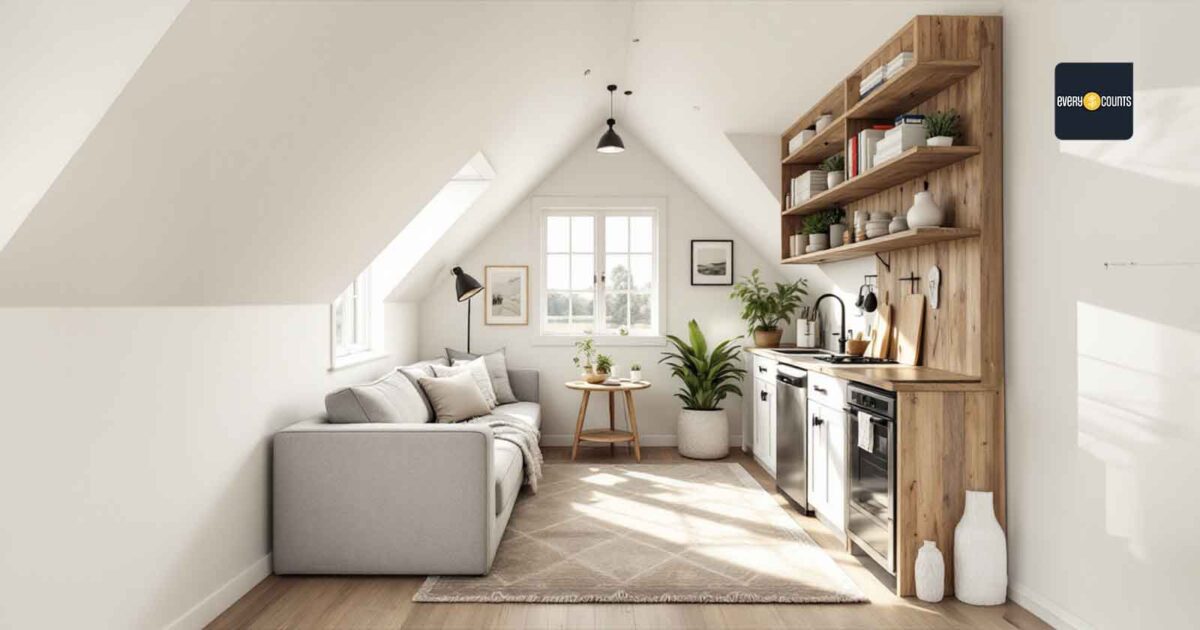The tiny home movement has taken the USA by storm in a world where less is often more. These compact, efficient spaces are not just a housing trend but a lifestyle choice promoting simplicity, sustainability, and financial freedom. But living comfortably in a tiny home requires more than just downsizing; it’s about smart design, thoughtful budgeting, and embracing a minimalist mindset.
One of the most important aspects of tiny home living is decorating your space. Why? Because a well-decorated tiny home doesn’t just look good—it feels good. It maximizes functionality, reflects your personality, and turns a small space into a cozy sanctuary. Ready to learn how to live comfortably in a tiny home without breaking the bank? Let’s dive into budget tips for minimalist living in the USA.
Table of Contents
What is a Tiny Home?
A tiny home is a compact living space, typically ranging from 100 to 400 square feet. These homes are designed to maximize every inch of space, often featuring multi-functional furniture, clever storage solutions, and energy-efficient systems. The tiny house movement in the USA has gained popularity as people seek affordable, sustainable, and minimalist living options.
How to Live Comfortably in a Tiny Home
Living comfortably in a tiny home is all about making the most of your space while staying within your budget. Here are some practical tips to help you thrive in your tiny home:
1. Plan Your Layout Wisely
The key to comfortable tiny home living is a well-thought-out layout. Prioritize open spaces and multi-functional areas. For example, a fold-out dining table or a sofa bed can save space while adding functionality.
2. Invest in Multi-Functional Furniture
Furniture that serves multiple purposes is a game-changer for tiny homes. Think storage ottomans, wall-mounted desks, and lofted beds with drawers underneath. These pieces help you maximize space without sacrificing comfort.
Also Read:
- Advanced Strategies: Savings of $100,000 in 3 years
- Affordable Minimalism: Declutter Your Life and Save Money
- 10 Thrift Store Hacks to Decorate Your Home for Under $50
- 10 Most Affordable US Cities to Live in 2025-2026
- How to Find Affordable Housing in Expensive US Cities in 2025
- Simple Tips to Save Money While Living in the USA
- 20 Cheapest, Safest Places to Live in the US in 2025-2026
- Tips for Moving Across the USA on a Tight Budget
- How College Students in the USA Can Live on a Budget?
- Top 10 Places to Buy Affordable Groceries in the USA
3. Declutter Regularly
Minimalist living means keeping only what you truly need. Regularly declutter your tiny home to free up space and create a more relaxing environment.
4. Use Vertical Space
When floor space is limited, think vertically. Install shelves, hooks, and hanging organizers to make use of wall space. This is especially useful for storing kitchen utensils, books, and clothing.
5. Choose Light Colors and Mirrors
Light-coloured walls and mirrors can make a tiny home feel more spacious and airy. Opt for neutral tones like white, beige, or light grey to create an open, inviting atmosphere.
6. Go Green with Energy-Efficient Appliances
Tiny homes are perfect for eco-friendly living. Invest in energy-efficient appliances and solar panels to reduce utility costs and minimize your environmental footprint.

Budget Tips for Tiny Home Living
Living in a tiny home can save you money, but it’s important to budget wisely. Here are some cost-saving tips for tiny home living in the USA:
1. Set a Realistic Budget
Before diving into tiny home living, determine your budget. What is a good budget for a tiny house? On average, a tiny home can cost anywhere from $20,000 to $100,000, depending on size, materials, and customization. Set a budget that works for you and stick to it.
2. DIY Where Possible
Building or customizing your tiny home yourself can save thousands of dollars. From painting walls to assembling furniture, DIY projects are a great way to cut costs.
3. Shop Secondhand
Furnishing a tiny home doesn’t have to be expensive. Check out thrift stores, garage sales, and online marketplaces for affordable, high-quality furniture and decor.
4. Minimize Utility Costs
Tiny homes are inherently energy-efficient, but you can save even more by using LED lighting, low-flow faucets, and a composting toilet.
5. Consider Tiny Home Communities
Joining a tiny home community can reduce land costs and provide access to shared amenities like laundry facilities and community gardens.
Decorating Your Tiny Home on a Budget
Decorating your tiny home is where you can truly make it feel like yours. Here are some budget-friendly decor ideas:
1. Add Personal Touches
Incorporate items that reflect your personality, like family photos, artwork, or travel souvenirs. These small touches can make your tiny home feel warm and inviting.
2. Use Plants for a Fresh Look
Indoor plants not only add colour and life to your tiny home but also improve air quality. Choose low-maintenance plants like succulents or snake plants.
3. Opt for Minimalist Decor
Less is more when it comes to tiny home decor. Stick to a few statement pieces rather than cluttering your space with too many items.
4. Play with Textures
Add depth and interest to your tiny home by mixing textures. Think cozy rugs, knitted throws, and wooden accents.
The Benefits of Tiny Home Living
Living in a tiny home offers numerous benefits, including:
- Financial Freedom: Lower mortgage payments and utility bills mean more money for experiences and savings.
- Sustainability: Tiny homes use fewer resources and produce less waste, making them an eco-friendly choice.
- Simpler Lifestyle: Minimalist living encourages you to focus on what truly matters, reducing stress and increasing happiness.
Living comfortably in a tiny home is not just about surviving in a small space—it’s about thriving. By embracing minimalist living, budgeting wisely, and decorating thoughtfully, you can create a tiny home that’s both functional and beautiful. Whether you’re drawn to the tiny house movement for financial reasons, environmental concerns, or a desire for simplicity, these budget tips for tiny home living in the USA will help you make the most of your small space.
So, are you ready to downsize and start your tiny home journey? With the right mindset and a few clever strategies, you can live comfortably, affordably, and happily in your tiny home.
FAQ:
What is a Good Budget for a Tiny House?
The cost of a tiny home varies widely based on size, materials, and location. On average, a DIY tiny home can cost $20,000 to $50,000, while professionally built models can range from $50,000 to $100,000. Setting a realistic budget is key to avoiding overspending.
Are Tiny Homes Tax Deductible?
In some cases, yes. If your tiny home is classified as an RV or a mobile home, you may qualify for tax deductions on interest payments. However, tax laws vary by state, so consult a tax professional for advice.
What is One Major Concern of Owning a Tiny Home?
One major concern is zoning laws and building codes. In many areas, tiny homes face strict regulations, making it challenging to find legal places to park or build. Research local laws before investing in a tiny home.
Can I live in a tiny home year-round?
Yes, many people live in tiny homes year-round. However, you’ll need to ensure your home is well-insulated and equipped for all seasons. Consider adding heating, cooling, and energy-efficient systems to stay comfortable.
What are the benefits of tiny home living?
Tiny home living offers several benefits, including:
Financial freedom: Lower mortgage payments and utility bills.
Sustainability: Reduced environmental impact due to smaller energy and resource usage.
Simpler lifestyle: Less clutter and more focus on experiences rather than possessions.
Can I build a tiny home myself?
Yes, many people choose to build their tiny homes to save money and customize the design. However, building a tiny home requires basic construction skills, tools, and time. If you’re not confident in your abilities, consider hiring a professional or purchasing a pre-built model.
Are tiny homes eco-friendly?
Yes, tiny homes are generally eco-friendly due to their smaller size, which requires fewer resources to build and maintain. Many tiny homeowners also incorporate sustainable features like solar panels, composting toilets, and energy-efficient appliances.
What utilities do I need for a tiny home?
Tiny homes typically require the same utilities as traditional homes, including:
Electricity (often solar-powered).
Water (from a well, city supply, or rainwater collection system).
Sewage (composting toilets or septic systems).
Heating and cooling systems.












